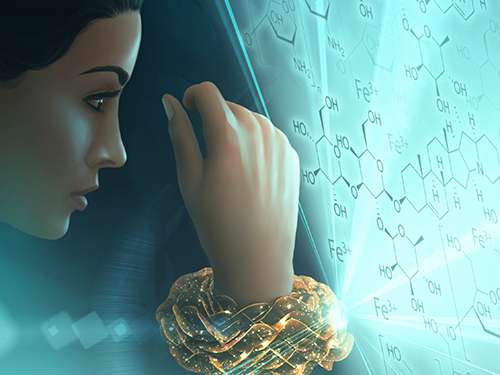Hybrid organic-inorganic materials can self-assemble into tiny doughnut-like structures

Engineered nanometer- and micrometer-scale structures have a vast array of uses in electronics, sensors and biomedical applications. Because these are difficult to fabricate, KAUST researchers are trying a bottom-up philosophy, which harnesses the natural forces between atoms and molecules such that microstructures form themselves.
This approach, a departure from the usual top-down approach, involves the etching away of material to leave the desired sculpted structure behind; however, because this approach can be tricky, expensive and time consuming, KAUST researchers became motivated to find a new approach.
Associate Professor of Chemical Science Niveen Khashab and her team and colleagues from the Imaging and Characterization Core Lab and the Max-Planck-Institute of Colloids and Interfaces in Germany demonstrated this bottom-up approach in the self-assembly of microscale toroids (doughnut-shaped forms), made of both inorganic and organic materials1.
A number of forces can bring atoms and molecules together. These include surface tension, electrostatic attraction and repulsion, and a weak fundamental force known as van der Waals interactions. The toroids created by Khashab's team were formed via metal coordination. A metallic sodium chloride atom, an amphiphilic (both hydrophilic and lipophilic) molecule called saponin and a polymer known as chitosan were combined and formed weak chemical bonds.
"This is a result of what is known as coordination-driven self-assembly," explained Khashab. "The metal ions interact with different chemical motifs leading to the formation of novel frameworks and morphologies."
Within just a few minutes, coordination bonding between the iron atoms and the oxygen and the hydrogen in the molecules initially drives the self-assembly of star-like nanostructures. Repulsive electrostatic and hydrophobic interactions then lead to the formation of toroids.
The toroids were approximately 3.9 to 4.8 micrometers in diameter and held their shape even a month after fabrication. Disassembly of the microstructures required five hours of mechanically stirring the solution.
There are numerous naturally occurring biological structures that take a toroid shape; for example, proteins and DNA of some types of viruses and bacteria self-assemble in this way. Many of these are known to play an important role in the formation of pores in biomembranes.
This research could help to build a better understanding of how these complex biostructures are created and provide a way of mimicking them at the molecular level.
"Next, we hope to prepare a new generation of these hybrid structures with a temperature-responsive gap size," said Khashab. "These toroid structures could be used as pockets for active catalysis and separation."
More information: Safa'a Al-Rehili et al. Anisotropic Self-Assembly of Organic–Inorganic Hybrid Microtoroids, Journal of the American Chemical Society (2016). DOI: 10.1021/jacs.6b10080
Journal information: Journal of the American Chemical Society




















